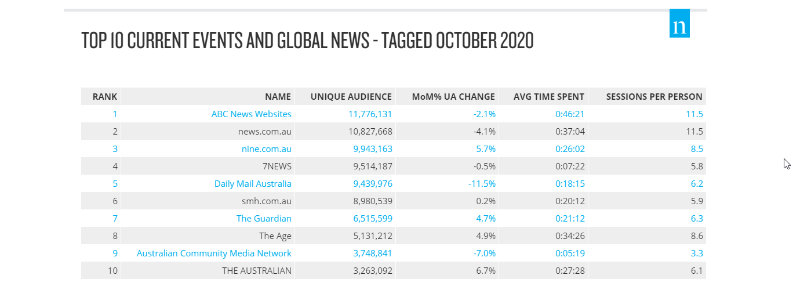Independent media winning the battle of the online audience
November 24, 2020
Independent media, online and print, continues to grow. Meanwhile, traditional media is under threat on many fronts, driven by stalling readership and declining revenue. News Corp, in particular, is losing out in the online audience stakes.
The onset of the pandemic at the beginning of the year sparked a growth spurt for most media outlets with the public thirsty for information on, and a better understanding of, Covid-19. As lock-downs hit and people found themselves with unwanted spare time, media consumption reached new heights in April and May. However, in recent times there have been signs of lethargy setting in as we collectively tire of the bad news and uncertainty.
Latest Roy Morgan Survey of newspaper readership
The survey covers the past 12 months to September 2020 and shows that the increased hunger for news is not reflected in newspaper readership. Of the 20 major metropolitan mastheads, their combined daily print readership (Monday to Friday) dropped by 100,000 per day (from 3.4 million to 3.3 million).
Its a similar story on weekends for those same mastheads with daily readership virtually unchanged over the past 12 months.
The aggregate numbers hide both winners and losers. The Australian is up with a combined readership (Monday to Saturday) of 13.7%, yet its Murdoch-owned stablemate, Sydneys Daily Telegraph is losing ground to the Sydney Morning Herald, while in Melbourne both The Age and the Herald Sun continue to shed readers, except on Sundays.
Notable exceptions to the trends are The Saturday Paper, up 61.2%, and the Canberra Times also thriving, freed from the shackles of Nine Media ownership and up by 41.7%.
These numbers are based on surveys of readership, not actual circulation, and exclude online readership and apps. (Note 1).
Online is the name of the game
Although print circulation and readership continues their decline, online continues to grow and to show a very different picture of readership. While Murdochs News Corp and Nine/Fairfax still dominate print readership, online the leader is the ABC.
According to the latest Nielsens Digital Audience Measurement of October 2020, ABC leads the Current Events and News category with a monthly unique audience of 11.77 million readers (Note 2). More importantly, News Corp sites (news.com.au and TheAustralian.com.au) constitute just 17.8% of the top 10 total online audience. Nine/Fairfax properties represent 42%, leaving mainstream independents with 40.2% of the total readers in the top 10. In addition to the ABC, the independents comprise the Daily Mail, The Guardian and the Australian Community Media Network (formerly Fairfax regional).

Independents are on the rise
As previously reported here, independent media represents a smallish, but fast-growing segment of the Australian online media landscape. Unaligned, the mostly independently owned and operated media offers a diverse range of coverage - niche news, investigative journalism, analysis, comments and opinions.
Reflecting its print growth, _The Saturday Paper_s online audience is up by 38% since January. However, this pales in comparison with the Adelaide-centric Indaily.com.au, which has trebled its audience this year. Maybe a reflection of otherwise stale media in the City of Churches.
The largest publisher in this category is The Conversation, which continues to grow its Australian audience - up by 96% since we last measured its web-traffic in January 2020. The New Dailys online audience is up 21% over the past 12 months, while Crikey has grown by 57.3%, which is especially impressive given it is one of the few sites in this sector that is behind a paywall.
Pearls & Irritations continues to grow strongly and, together with its associated Michael West Media, have almost doubled combined traffic since January.
But it is not all roses for independents: some of the mainstays of the sector are struggling, including, sadly, those that focus on satire. Maybe we have all lost a bit of our sense of humour in this rather calamitous year!
Overall, the 30 sites measured in this category (Note 3) have grown their audience by 9.5% in the past nine months.
Regional papers
These are hurting the most with declining readership and disappearing advertising revenue. Some are having success online and the early signs are that Antony Catalanos ACMA is turning things around with the larger mastheads as mentioned above.
Catalano is reportedly in talks with News Corp to acquire its regional newspapers. As Murdochs dominance continues to decline - at least online - a new monopoly may emerge that will dominate regional media.
Meanwhile, the ACCC is dragging its feet on completing the recommendations from the Digital Platform Report, while the Senate has announced another inquiry into the media. Its due to report in March. By then, all we know is that the media landscape will have changed even more.
Notes
(1) Accurate newspaper circulation statistics in Australia has been lacking ever since NewsCorp withdrew from the AMAA circulation audit. The latest figures go back to 2018 with a 10% decline. Paradoxically the shift to on-line has made comparative figures of circulation and readership even harder to come by.
(2) A unique reader is normally defined as someone who has visited the website at least once during a particular month. The Nielsen figures include Apps, and for those publishers that publish on both platforms it is likely that some double counting will occur.
(3) Data collected by theIndependents.org.au - a portal for independent media, courtesy of SimilarWeb - a global web measurement company.
